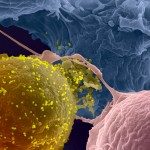Link to Pubmed [PMID] – 25464829
Cell Host Microbe 2014 Dec;16(6):736-47
The interferon-induced transmembrane (IFITM) proteins protect cells from diverse virus infections by inhibiting virus-cell fusion. IFITM proteins also inhibit HIV-1 replication through mechanisms only partially understood. We show that when expressed in uninfected lymphocytes, IFITM proteins exert protective effects during cell-free virus infection, but this restriction can be overcome upon HIV-1 cell-to-cell spread. However, when present in virus-producing lymphocytes, IFITM proteins colocalize with viral Env and Gag proteins and incorporate into nascent HIV-1 virions to limit entry into new target cells. IFITM in viral membranes is associated with impaired virion fusion, offering additional and more potent defense against virus spread. Thus, IFITM proteins act additively in both productively infected cells and uninfected target cells to inhibit HIV-1 spread, potentially conferring these proteins with greater breadth and potency against enveloped viruses.
